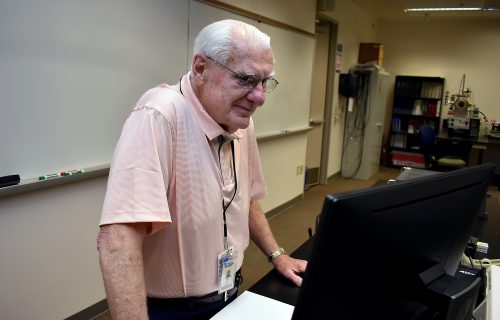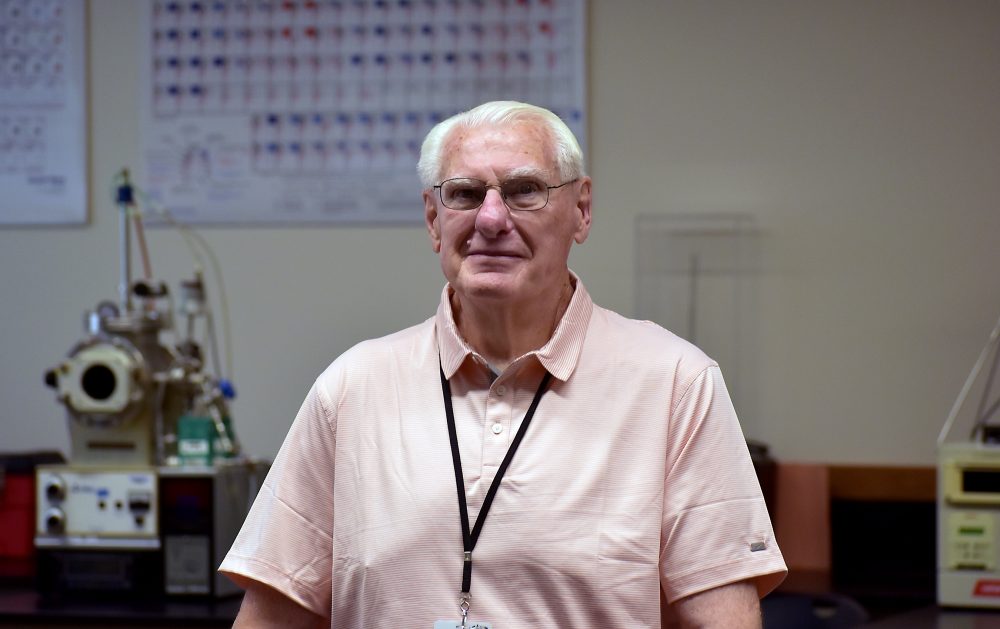PCC’s ‘job broker’ connects microelectronics grads to industry opportunities
Story by Grace Booth. Photos by James Hill.
Portland Community College’s Microelectronics Technology (MT) Program is one of the region’s hidden gems. The program’s training and industry aligned instruction has resulted in a nearly 100% job placement rate for students who graduate.
Not only is the job placement rate golden, but these are also jobs in which students are excited to work. Starting salaries are between $56,000 to $65,000 per year, and graduates work for well-known companies like Intel, Qorvo, Analog Devices, Inc (ADI)ted, Lam Research and others in the local area.
Why this program has such a high success rate is largely thanks to the work of microelectronics staff and people like Manley. He works as the employment specialist for the MT program.
Semiconductor Training
PCC has built a healthy semiconductor pathway to address the worker shortage. From short-term introductory courses to the industry offering programs like Quick Start to two-year degrees in microelectronics and electronic engineering, PCC offers many options to learn the principles of advanced manufacturing that provide pathways to living wage jobs and long-term careers in semiconductors.
Manley hasn’t always had a career in MT, he actually went to school and started working several years before the semiconductor industry and MT even existed. The semiconductor industry started becoming mainstream in the 1990’s, and has boomed since then, becoming a giant industry that employs thousands of people locally. Manley had worked for more than 17 years in different PCC positions before retiring. But after six years of retirement, he was asked to return to the college to assist the MT program.
A typical day at work for the Beaverton resident involves helping students prepare their resumes, connecting them with companies who are hiring, and helping them develop interview skills that are specific to the industry. With his help, students gain more confidence going into job interviews and graduate with jobs lined up.
“Washington County has so many high-tech companies in the area that it has earned the nickname ‘Silicon Forest,'” said Manley. “PCC is the only local college in the area that has an MT program. This makes my work extremely important.
“In addition to helping students, I also connect with companies in the area,” he continued. “I find out how many and what type of technicians they need. I then use this information to guide students in their education and job search process.”
PCC also works very closely with local semiconductor companies to design their MT program. They find out exactly what education and skills companies are looking for, and tailor their program to fit those needs.
“This is why the program is able to have such a high job placement rate,” Manley said.
The MT program is open to anyone with interest in the industry. No experience is needed, and there are even classes on things like basic hand tool use to make sure anyone can join. People like Manley are also there to help students every step of the way, ensuring they feel prepared to complete the program.
Unlike some other programs at PCC, it is an “open program,” meaning there is more flexibility and the ability to work around your own schedule. Another contrast to other PCC programs is that classes are on a compressed work week schedule to accommodate students’ schedules.

PCC is the only area college that has a microelectronics program to feed workers to the ‘Silicon Forest.’
“The compressed work week schedule reflects the jobs of many careers in the semiconductor industry, which have employees working 12-hour shifts three to four days a week,” he said. “This schedule also allows students to have part time internships while working on their degree.”
Several companies offer opportunities for MT students to obtain internships in the field, which is another thing Manley helps with. Students who get internships usually obtain full-time positions with the same company after graduation, and often don’t even have to interview for a full-time job.
“The program is looking for more students, especially women,” Manley added. “Companies are also looking to hire many people as the industry is quickly expanding and companies are currently unable to hire enough employees to keep up.”
He said his favorite thing about working with students is seeing how much they transform throughout the two years of the program. He added that many people come in not even knowing what a chip is, but only know that these are good jobs.
“When they leave the MT program, they are an entirely different person with a passion for the industry and excitement about future opportunities,” he said.
When Manley first accepted his position, he thought it would be temporary. Now, in his tenth year on the job, he is looking forward to helping more students and graduates connect with semiconductor factories (fabs) to work in their cleanrooms and start rewarding careers.
For more details, visit the Microelectronics Technology Program webpage.

